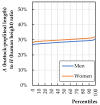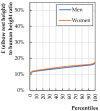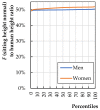Chair Size Design Based on User Height
- PMID: 36810388
- PMCID: PMC9944090
- DOI: 10.3390/biomimetics8010057
Chair Size Design Based on User Height
Abstract
General principles derived from anatomical studies of human body sizes should be applied to chair designs. Chairs can be designed for a specific user or a particular group of users. Universal chairs for public spaces should be comfortable for the largest possible group of users and should not be adjustable, such as office chairs. However, the fundamental problem is that the anthropometric data available in the literature either come from many years ago and are out of date or do not provide a complete set of all the dimensional parameters of a sitting human body position. This article proposes a way to design chair dimensions solely based on the height range of the intended chair users. For this purpose, based on literature data, the main structural dimensions of the chair were assigned to the appropriate anthropometric body measurements. Furthermore, calculated average body proportions for the adult population overcome the incompleteness, outdated and burdensome access to anthropometric data and link the main chair design dimensions to one easily accessible anthropometric parameter: human height. This is achieved by seven equations describing the dimensional relations between the chair's essential design dimensions and human height or even a height range. The result of the study is a method of determining the optimal functional dimensions of a chair for a chosen range of sizes of its future users based only on users' height range. Limitations of the presented method: the calculated body proportions are correct only for people with a standard body proportion characteristic of adults, i.e., they exclude children and adolescents up to 20 years of age, seniors, and people with a body mass index exceeding 30.
Keywords: anthropometry; chairs; furniture design; lumbar support; seat depth; seat height; seat width.
Conflict of interest statement
The authors declare no conflict of interest.
Figures













References
-
- Biomimetics—Terminology, Concepts and Methodology. International Organization for Standardization; Geneva, Switzerland: 2015.
-
- Sydor M., Zabłocki M. Wybrane problemy doboru i konfiguracji wózka inwalidzkiego z napędem ręcznym / Chosen problems of manual wheelchair selection and configuration. Fizjoterapia Pol. 2006;2:172–177.
-
- Openshaw S., Taylor E. Ergonomics and Design: A Reference Guide. Allsteel Inc.; Muscatine, IA, USA: 2006.
-
- Gedliczka A., Pochopień P. Atlas Miar Człowieka: Dane Do Projektowania i Oceny Ergonomicznej: Antropometria, Biomechanika, Przestrzeń Pracy, Wymiary Bezpieczeństwa/Atlas of Human Measures: Data for Ergonomic Design and Assessment: Anthropometry, Biomechanics, Work Space, Safety Dimensions. Centralny Instytut Ochrony Pracy; Warszawa, Poland: 2001.
-
- Tilley A.R., Dreyfuss H., editors. The Measure of Man and Woman: Human Factors in Design. Wiley; New York, NY, USA: 2002.
Grants and funding
LinkOut - more resources
Full Text Sources

